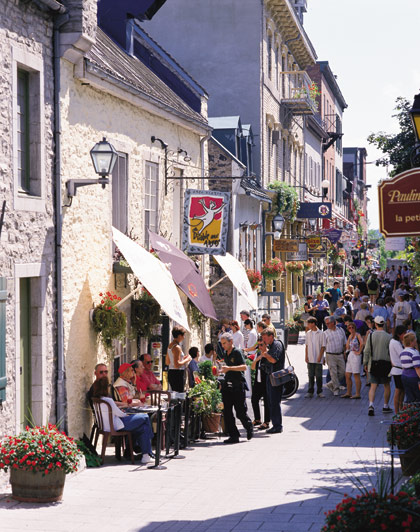Walk down the aisles of any well-stocked beer store and you will notice there is a quiet revolution taking place. Caged-corked champagne-style bottles of Belgian-inspired beer are invading the shelves. If you have stopped to wonder who is responsible, blame Canada. Specifically, blame Quebec.
The contrary French cast of mind is demonstrated in a tendency to defy convention, even with the most pedestrian of beers.

Petit-Champlain Street, Quebec City (Yves Tessier, Tessima )
More specifically, if there is a single French Canadian to blame, it is Andre Dion, one of the founders of Unibroue. One of Canada’s most impressive breweries turns out some of the most distinctive Belgian-style ales on this side of the Atlantic.
After a buying trip to Belgium, Dion was so smitten by the white beers he found there that he quit his job as president of mega-hardware giant Rona Inc. to enter the beer business. In 1990, Dion and a business partner obtained a 75 percent interest in the struggling Massawippi brewery in Lennoxville, one of Quebec’s oldest breweries. By the end of 1991 they owned Massawippi outright. In 1993, they moved the brewing facilities to Chambly, Quebec.
Unibroue predates such North American Belgian-style stalwarts as Colorado’s New Belgium Brewery by one year, Maine’s Allagash by five years and upper state New York’s Ommegang by seven years. Coincidentally, the first product for both Allagash and Unibroue was a Belgian styled white beer. But that still doesn’t explain why beer lovers in Quebec are ahead of the rest of North America in embracing Belgian style beers.
The French Connection
Like all trends or historic events there is a series of smaller, less noticeable episodes that cumulatively lead to the final result. In this case, a French mindset and a love of all things culinary are key to the Belgian-styled ale explosion in Quebec North America.
The contrary French cast of mind is demonstrated in a tendency to defy convention, even with the most pedestrian of beers. Unlike the rest of North America, where yellow bubbly macro lager is king, in Quebec the ale reigns supreme: the two most popular products in Quebec are Molson Export and Labatt’s 50, both of which are ales.
Some say the Quebecois and the Walloons, or French Belgians, share a like viewpoint. They are both French-speaking ethnic groups. Yet neither feels accepted by the French themselves, and both feel oppressed by the larger populace in their own countries—English Canadians and the Flemish, respectively.
This shared outlook translates into shared beer affinities: Look in any well-stocked beer section or any brewpub in Quebec and you will see a large representation of Walloon beer styles like saisons and hoppy blond ales.
Quebec has long been known as a culinary bright light in Canada and one area where the Quebecois resemble Belgians is in their love of cheese. The two areas each manufacture over 300 different cheeses. When Winston Churchill once proclaimed that, “Any country with two hundred cheeses must be healthy,” Charles De Gaulle countered with “Any country with three hundred cheeses must be ungovernable.” By these standards, Quebecers ought to be very long-lived anarchists, though to date they have only shown occasional, unsuccessful inclinations toward separation from the rest of Canada.
Essence of Quebec
French Canadians are intensely proud of their heritage, and Unibroue has captured this essence like no other Quebec brewery. The company tapped into this sentiment by incorporating Quebec’s early history, myths and legends in the names of their beers and the artwork on their labels. They integrate the early period of New France and the early settlement of Canada, celebrating the inhabitants and voyageurs, or first pioneers, of the new land. They also mirror the Belgian custom of naming beers along the themes of death and religion, with beers such as La Fin du Monde (End of the World), Maudite (The Damned), and Eau Benite (Blessed Water).
Unibroue melds French Canadian passion for beer and food through its involvement in one of the world’s truly great bière et cuisine restaurants, Le Fourquet Fourchette. The name of this establishment means “the mashing fork (a brewery tool) and the culinary fork” and the restaurant’s symbol intertwines the two to illustrate the harmony of beer and food. The restaurant focuses on the foods of New France and native North Americans, with delicacies made from locally grown products, and unbelievable French Canadian dishes of Old World style featuring caribou, fish, lamb, chicken and duck—all cooked in, or paired with, a matching Unibroue beer.
The interior is magnificent and conjures up images of the voyageur and trapper life in New France or old Canada. The staff dress in period Habitants (farmers) wear and the place is dripping with Quebecois atmosphere, right down to the oddly-sized Sherwood Forest chairs and the one-of-a-kind light fixture shaped like a birch bark canoe that hands over the bar.
The stunning terrace provides a magnificent view of the Chambly Basin from the banks of the Richelieu River. For a peek at how pretty the area is, just look at the illustration on a bottle of Blanche de Chambly.
Le Fourquet Fourchette also has an interesting store in the front of the restaurant that stocks Unibroue beers and products made from their beers, including jams, vinegars and mustards. There are also produits de terroir, or locally-sourced and produced cheeses, sausages, jerkies, smoked meats and other delicious treats.









